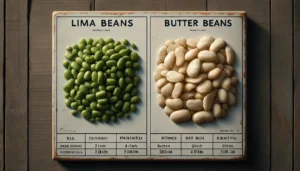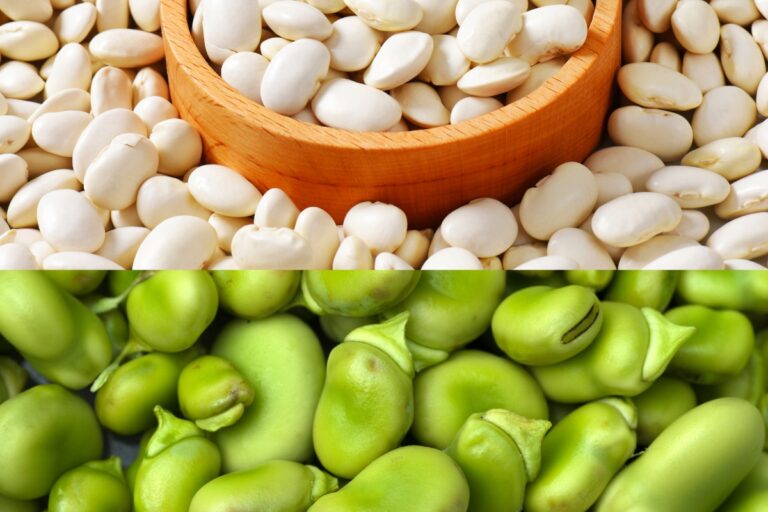When it comes to legumes, not all beans are created equal. The difference between lima beans and butter beans might seem subtle to the untrained eye, but they have distinct characteristics that set them apart. This article will dive deep into their origins, physical traits, culinary uses, and health benefits, providing you with all you need to know about these versatile beans. Whether you’re a home cook looking to switch up your recipes or a health enthusiast curious about their nutritional impact, understanding these differences can enhance your cooking and eating experience.
Introduction to Lima and Butter Beans
Lima beans and butter beans are staples in many kitchens around the globe, often hailed for their versatility and health benefits. But what exactly sets these two beans apart? Let’s crack the shell on this legume mystery and explore the intriguing world of these popular beans.
Origins of Lima Beans
Believed to have originated in Central America, lima beans have been a vital source of nutrition for thousands of years. Historical records suggest that Native American communities valued lima beans for their ability to thrive in various climates and their ease of storage. These beans were not only a staple food but also a bartering commodity in ancient times.
Origins of Butter Beans
On the other hand, butter beans, often embraced in Southern cooking, trace their roots back to South America. Renowned for their creamy texture and slightly sweet flavor, butter beans have carved out a niche in various regional cuisines around the world. They were particularly revered by ancient civilizations like the Incas, who cultivated them for their robustness and nutritional value.
This exploration into the origins of lima and butter beans sets the stage for a deeper understanding of their unique characteristics and culinary roles. As we delve further into their distinct appearances and flavors, the nuances of each bean variety will become increasingly clear, highlighting why they hold such a revered place in culinary traditions worldwide.
Physical Characteristics of Lima and Butter Beans
Exploring the physical characteristics not only enriches our understanding but also helps identify them in markets or recipes. These traits impact not just the appearance but also the texture and flavor profiles of the beans, which are crucial for culinary applications.
Size, Color, and General Appearance
Lima beans and butter beans differ markedly in size, color, and appearance, characteristics that can significantly affect their use in cooking. Here’s a quick breakdown:
| Feature | Lima Beans | Butter Beans |
|---|---|---|
| Size | Smaller, more compact | Larger, plumper |
| Color | Generally greenish-white | Creamy white to light yellow |
| Texture | Slightly firmer | Creamier and softer |
| Shape | Typically flat and oval-shaped | More rounded and kidney-shaped |
Taste and Texture Differences
When it comes to taste and texture, both beans offer unique profiles that can enhance various dishes. Lima beans have a starchy texture and a subtly sweet flavor, making them perfect for dishes where they can absorb flavors from other ingredients. In contrast, butter beans are known for their creamy texture and buttery taste, which makes them a favorite in richer, more flavor-forward recipes.
Understanding these differences is key to utilizing each bean type to its fullest potential in the kitchen, ensuring that every dish is as delicious as it is nutritious. As we delve deeper into the nutritional value of these beans in the next section, the reasons for their popularity in health-conscious diets will become even more apparent.
Nutritional Value of Lima and Butter Beans
Delving into the nutritional aspects of lima and butter beans not only highlights their health benefits but also explains why they are favored in various diets. Both beans pack a substantial nutritional punch, making them an excellent addition to any meal seeking to boost dietary value.

Health Benefits of Lima Beans
Lima beans are a powerhouse of nutrition. They are rich in soluble fiber, which helps to lower cholesterol and manage blood sugar levels. Additionally, lima beans are an excellent source of protein, making them a fantastic option for plant-based diets. They are also high in important minerals like iron and magnesium, which support overall health.
- Protein Content: High
- Fiber Content: Very High
- Key Vitamins and Minerals: Iron, Potassium, Magnesium
Health Benefits of Butter Beans
Butter beans offer similar nutritional benefits, with a few distinctions. They are particularly rich in B vitamins, which aid in energy metabolism and nerve function. Butter beans also provide a good amount of antioxidants, which can help combat oxidative stress and inflammation.
- Protein Content: High
- Fiber Content: High
- Key Vitamins and Minerals: Folate, Zinc, Copper
In summary, both lima and butter beans are nutritional stalwarts that can significantly enhance the healthfulness of meals. Whether you are looking to improve digestive health, boost protein intake, or increase your vitamin and mineral consumption, these beans are an excellent choice. As we continue to explore their culinary uses, the versatility of lima and butter beans becomes even more apparent, demonstrating why they are cherished in kitchens worldwide.
Culinary Uses of Lima and Butter Beans
Lima beans and butter beans are celebrated not just for their nutritional benefits but also for their versatility in the kitchen. Each bean brings its unique flavor and texture to dishes, influencing the culinary landscapes of many cultures.
Common Recipes and Preparations for Lima Beans
Lima beans are a staple in many traditional dishes across the world. They are often found in stews, soups, and casseroles, where their ability to absorb flavors enhances the dish. Below are some common ways lima beans are used in cooking:
| Dish Type | Description |
|---|---|
| Soups and Stews | Lima beans add heartiness and texture to broths and stews. |
| Succotash | A classic Southern dish combining corn, lima beans, and other vegetables. |
| Salads | Cooked lima beans are a nutritious addition to salads, providing a satisfying crunch. |
Common Recipes and Preparations for Butter Beans
Butter beans are particularly favored in Southern and Creole cooking, where their creamy texture and rich flavor are highly valued. Here’s how butter beans are typically used:
| Dish Type | Description |
|---|---|
| Creole Dishes | Butter beans are often featured in rich, spicy Creole recipes. |
| Casseroles | They provide creaminess and depth to casseroles. |
| Side Dishes | Served simply with herbs and spices, butter beans make a delicious side. |
Understanding these uses is essential for anyone looking to incorporate more legumes into their diet. Both offer exceptional flavors and textures that can elevate simple dishes into something extraordinary. As we explore the varied and delicious ways these beans can be incorporated into meals, it becomes clear why they are such beloved ingredients in diverse culinary traditions.


